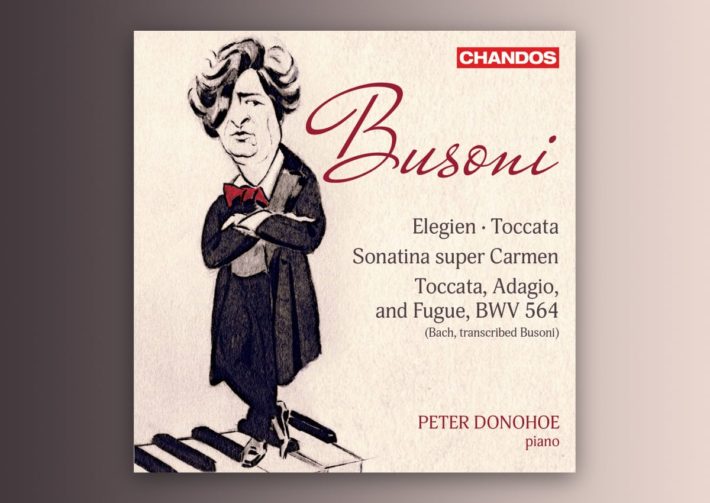Ferrucio Busoni is probably best knows as the master of transcription. His version of Bach’s D Minor Chaconne, for example, remains popular today for good reason: he transmutes a complex violin movement into a piano work of epic proportions that highlights the capabilities of both performer and modern instrument. He is lesser known, however, as a true composer—even in his lifetime, it was a rare occasion upon which he performed his own outputs (and of course even then, he would make consistent alterations.) In his latest release, Peter Donohoe presents a combination of Busoni’s original compositions and transcriptions.
The Elegien mark a departure from a previous, more Romantic style. For those expecting something along those lines, these distinctive pieces are especially intriguing. A good example is Nach der Wendung (track 4). The large, Lisztian sound that used to be so prevalent is now applied on a minute scale: the accompanimental figures in the beginning are mired deep in the piano’s bass. With Donohoe’s mindful control not to overpower the melody, an interestingly dense yet velvety texture arises. We also come across a more experimental element: curious dissonances coupled with hints of modality make the tonal center all but a moving target. Donohoe delivers an enigmatic sheen especially in the delicate moments, using the piano’s sparkling upper register to full effect.
In All’ Italia (track 5), which based upon Busoni’s own Piano Concerto, an imaginative performance brings out the evocative narrative. The murky first section, once again harmonically adventurous, builds in intensity to depict a wondrous and perilous journey (the chromatic scales are reminiscent of strong gusts of wind). The middle unfolds into a vivid scene, perhaps a joyful arrival at a bustling town. A dreamy mystery returns in the final part, but with a surprise: the final few chords are peaceful yet profoundly mysterious in their placement and relationship to the rest of the piece.
Related Classical Music Reviews
- Review: Mozart – Complete Piano Sonatas, Vol. 1 – Peter Donohoe
- Review: Bach-Busoni – Goldberg Variations, Chaconne – Chiyan Wong
- Review: “Encounter” – Igor Levit, Piano
The 1921 Toccata was written just three years before the composer’s death and draws upon motivic material from two of his operas, Doktor Faust and Die Brautwahl. Indeed, in Faustian fashion, the Preludio (track 1) throws us right into a series of agitated arpeggios and assertive dotted rhythms, all which serve to portray an inferno. Dohonoe’s noticeably dry articulation is quite effective in calling to view the menacing flames licking at one’s feet. The Fantasia is cryptic and ominous—and ever so briefly punctuated by fleeting moments of consonance and warmth. In the true spirit of the fantasia form, it twists and turns, often unpredictably. The performance itself is nonetheless expressive and eloquent. The following Ciaccona (track 3) is not necessarily any easier to decipher due to its extreme chromaticism, polytonality, and eclectic mix of textures. The ambiguity, however, is ultimately the source of suspense. The final moments seem to sum it up best: a pseudo-ending in D is abruptly interrupted by the ‘true’ resolution, a series of ferocious minor chords. For all its eccentricity and complexity, Donohoe embodies the tempo marking’s risoluto. His conviction is what guides us through this convoluted work.
When one juxtaposes Busoni’s transciption of Bach’s BWV 564 (Toccata, Adagio and Fugue) with the aforementioned selections, the differences are like night and day. What we have here is exuberant and sonorous, transforming the piano into an interesting hybrid of itself and its cousin, the organ (for which the original was written). Dohonoe also displays a different side of his playing by using a bold and brassy tone that fits right in. However, it’s not all just for show. The distinction in the dynamics (i.e. 0:50-1:11) goes beyond a mere forte vs. piano. Instead, it mimics a call-and-response and the different timbres possible on an organ. A strong Fugue has a pristine clarity to it throughout: not only can we can hear all the voices at work, but we can perceive the individuality of each. And when they come together in the final moments, the result is simply exhilarating.
On par with the recording, the liner notes are top-notch, generous in their informative introductions (especially of what we might be less familiar with). In sum, this album sheds light on Busoni’s interesting compositional profile: the unconventionality of his original pieces no doubt invites multiple listens to be better understood. Donohoe presents these works with finesse and in such a way that keeps our interest piqued throughout. Warmly recommended.

Busoni –
Toccata, BV 287
Elegien, BV 249 and BV 252 (‘Berceuse’)
Sonatina [No. 6] super Carmen, BV 284
Toccata, BV 29
Peter Donohoe – Piano
Recommended Comparisons
Read more classical music reviews or visit The Classic Review Amazon store
Follow Us and Comment:
Get our periodic classical music newsletter with our recent reviews, news and beginners guides.
We respect your privacy.









